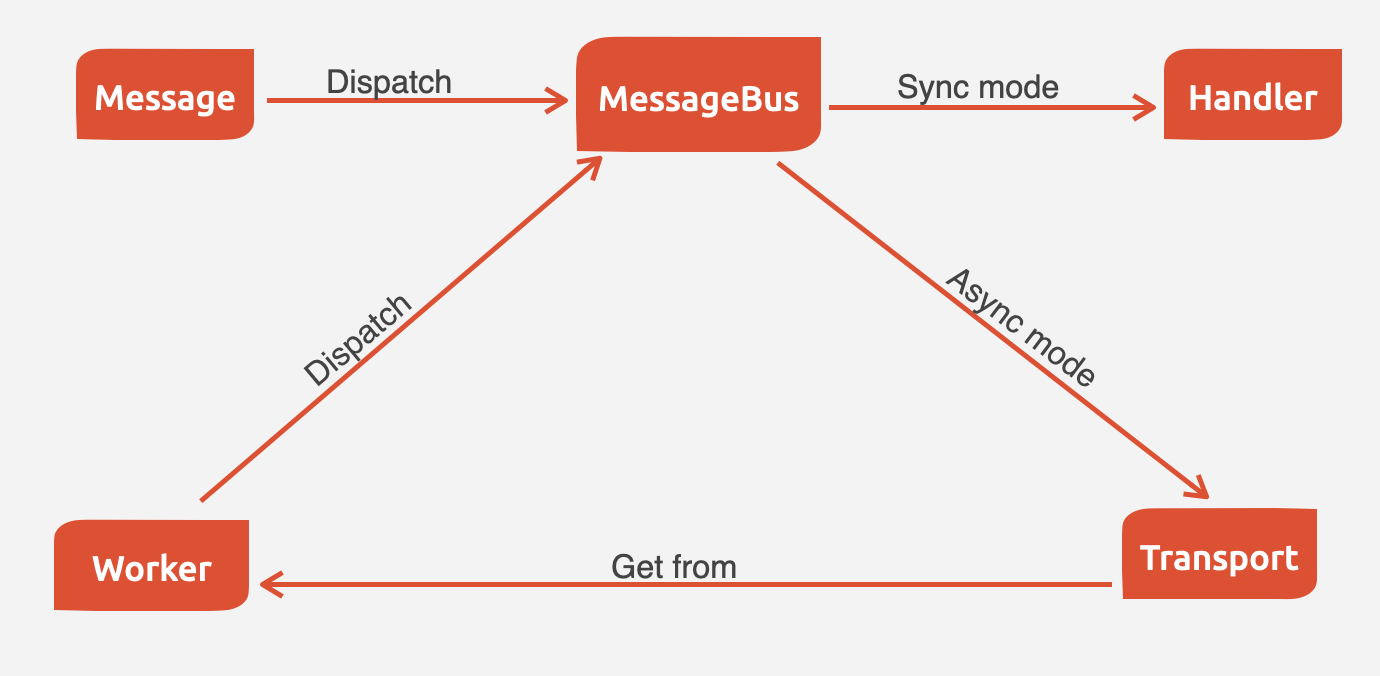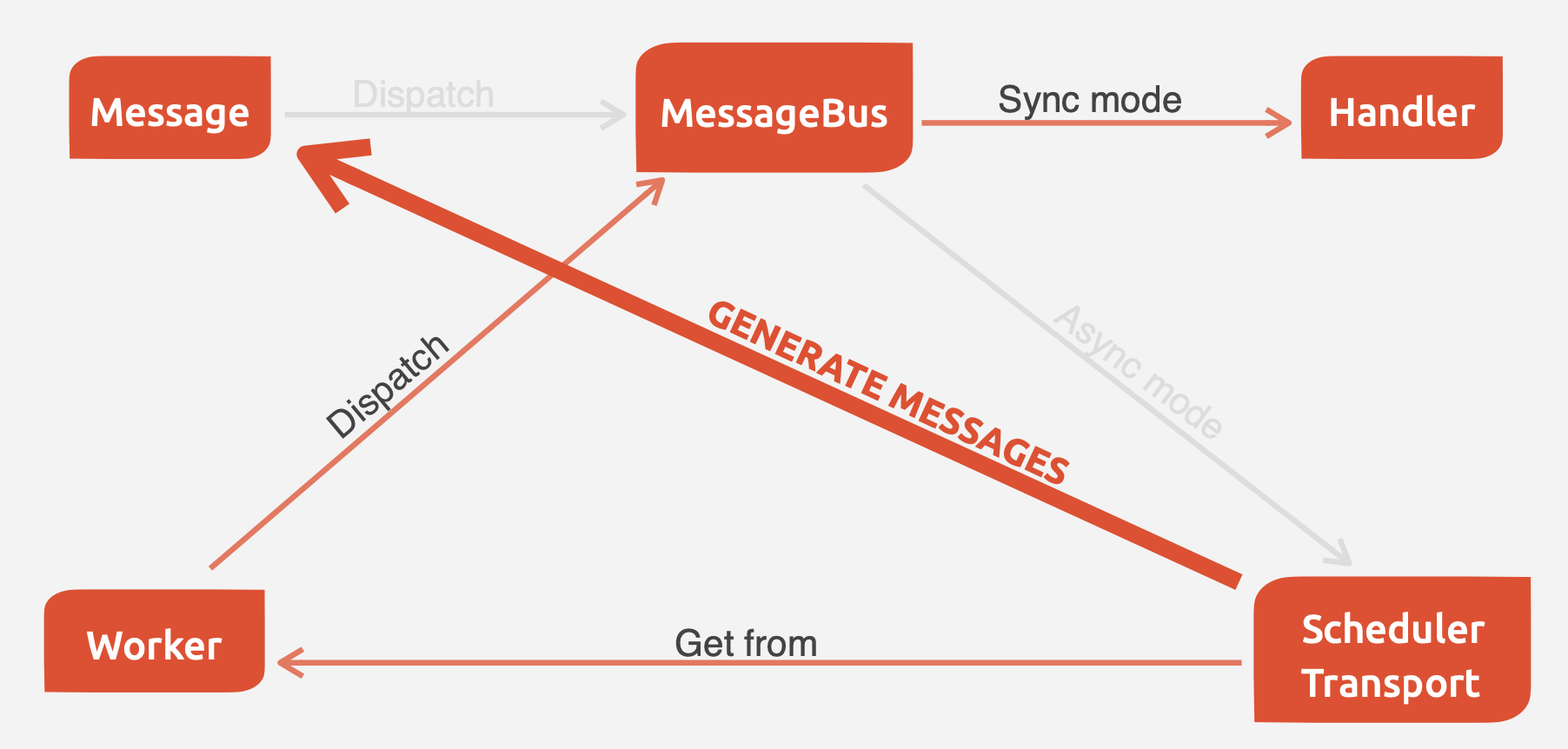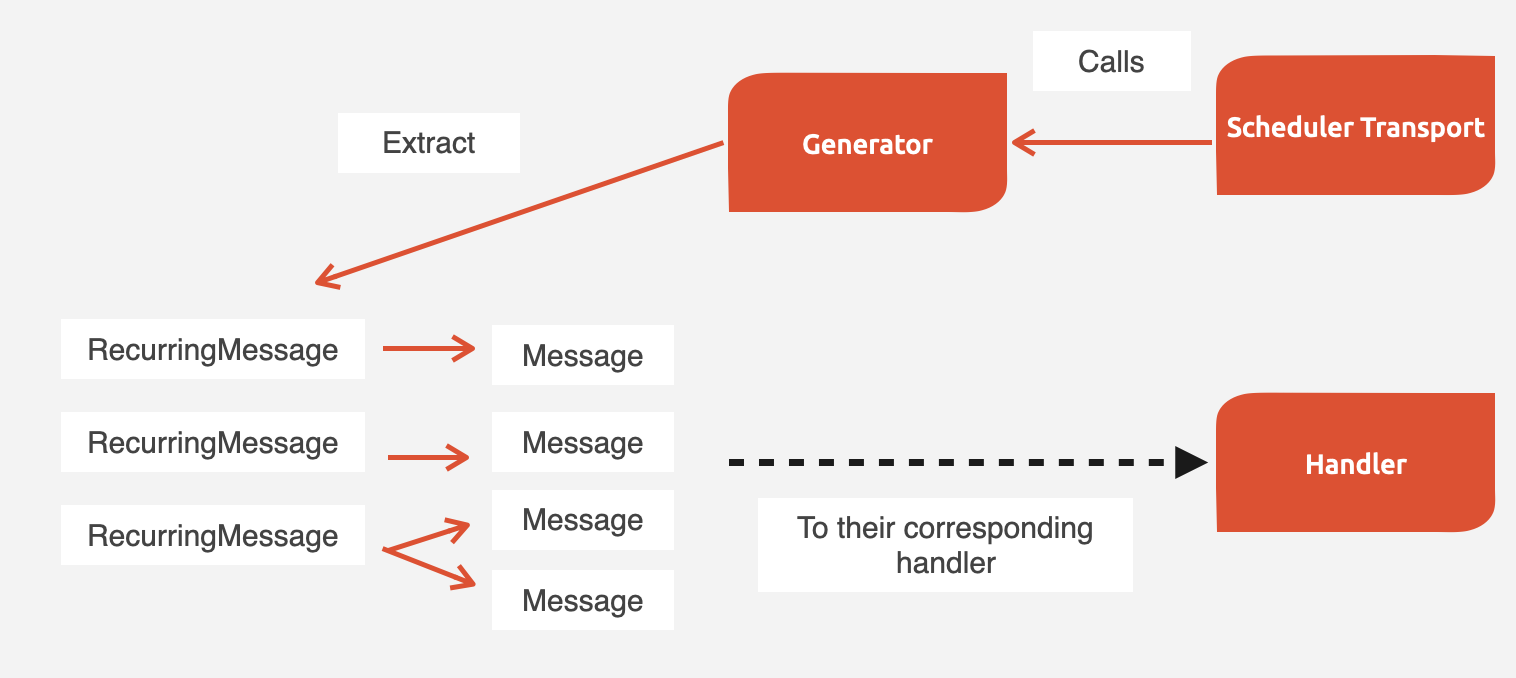Scheduler
Warning: You are browsing the documentation for Symfony 6.3, which is no longer maintained.
Read the updated version of this page for Symfony 8.0 (the current stable version).
6.3
The Scheduler component was introduced in Symfony 6.3
The scheduler component manages task scheduling within your PHP application, like running a task each night at 3 AM, every two weeks except for holidays or any other custom schedule you might need.
This component is useful to schedule tasks like maintenance (database cleanup, cache clearing, etc.), background processing (queue handling, data synchronization, etc.), periodic data updates, scheduled notifications (emails, alerts), and more.
This document focuses on using the Scheduler component in the context of a full stack Symfony application.
Installation
In applications using Symfony Flex, run this command to install the scheduler component:
1
$ composer require symfony/schedulerSymfony Scheduler Basics
The main benefit of using this component is that automation is managed by your application, which gives you a lot of flexibility that is not possible with cron jobs (e.g. dynamic schedules based on certain conditions).
At its core, the Scheduler component allows you to create a task (called a message) that is executed by a service and repeated on some schedule. It has some similarities with the Symfony Messenger component (such as message, handler, bus, transport, etc.), but the main difference is that Messenger can't deal with repetitive tasks at regular intervals.
Consider the following example of an application that sends some reports to customers on a scheduled basis. First, create a Scheduler message that represents the task of creating a report:
1 2 3 4 5 6 7 8 9 10 11 12
// src/Scheduler/Message/SendDailySalesReports.php
namespace App\Scheduler\Message;
class SendDailySalesReports
{
public function __construct(private int $id) {}
public function getId(): int
{
return $this->id;
}
}Next, create the handler that processes that kind of message:
1 2 3 4 5 6 7 8 9 10 11 12 13 14
// src/Scheduler/Handler/SendDailySalesReportsHandler.php
namespace App\Scheduler\Handler;
use App\Scheduler\Message\SendDailySalesReports;
use Symfony\Component\Messenger\Attribute\AsMessageHandler;
#[AsMessageHandler]
class SendDailySalesReportsHandler
{
public function __invoke(SendDailySalesReports $message)
{
// ... do some work to send the report to the customers
}
}Instead of sending these messages immediately (as in the Messenger component), the goal is to create them based on a predefined frequency. This is possible thanks to SchedulerTransport, a special transport for Scheduler messages.
The transport generates, autonomously, various messages according to the assigned frequencies. The following images illustrate the differences between the processing of messages in Messenger and Scheduler components:
In Messenger:

In Scheduler:

Another important difference is that messages in the Scheduler component are recurring. They are represented via the RecurringMessage class.
Attaching Recurring Messages to a Schedule
The configuration of the message frequency is stored in a class that implements ScheduleProviderInterface. This provider uses the method getSchedule() to return a schedule containing the different recurring messages.
The AsSchedule attribute,
which by default references the schedule named default, allows you to register
on a particular schedule:
1 2 3 4 5 6 7 8 9 10 11 12 13 14 15
// src/Scheduler/SaleTaskProvider.php
namespace App\Scheduler;
use Symfony\Component\Scheduler\Attribute\AsSchedule;
use Symfony\Component\Scheduler\Schedule;
use Symfony\Component\Scheduler\ScheduleProviderInterface;
#[AsSchedule]
class SaleTaskProvider implements ScheduleProviderInterface
{
public function getSchedule(): Schedule
{
// ...
}
}Tip
By default, the schedule name is default and the transport name follows
the syntax: scheduler_nameofyourschedule (e.g. scheduler_default).
Tip
Memoizing your schedule is a good practice to prevent unnecessary reconstruction
if the getSchedule() method is checked by another service.
Scheduling Recurring Messages
A RecurringMessage is a message associated with a trigger, which configures
the frequency of the message. Symfony provides different types of triggers:
- CronExpressionTrigger
- A trigger that uses the same syntax as the cron command-line utility.
- CallbackTrigger
- A trigger that uses a callback to determine the next run date.
- ExcludeTimeTrigger
- A trigger that excludes certain times from a given trigger.
- JitterTrigger
- A trigger that adds a random jitter to a given trigger. The jitter is some time that it's added/subtracted to the original triggering date/time. This allows to distribute the load of the scheduled tasks instead of running them all at the exact same time.
- PeriodicalTrigger
-
A trigger that uses a
DateIntervalto determine the next run date.
Most of them can be created via the RecurringMessage class, as shown in the following examples.
Cron Expression Triggers
Before using cron triggers, you have to install the following dependency:
1
composer require dragonmantank/cron-expressionThen, define the trigger date/time using the same syntax as the cron command-line utility:
1
RecurringMessage::cron('* * * * *', new Message());Tip
Check out the crontab.guru website if you need help to construct/understand cron expressions.
You can also use some special values that represent common cron expressions:
@yearly,@annually- Run once a year, midnight, Jan. 1 -0 0 1 1 *@monthly- Run once a month, midnight, first of month -0 0 1 * *@weekly- Run once a week, midnight on Sun -0 0 * * 0@daily,@midnight- Run once a day, midnight -0 0 * * *@hourly- Run once an hour, first minute -0 * * * *
For example:
1
RecurringMessage::cron('@daily', new Message());Hashed Cron Expressions
If you have many triggers scheduled at same time (for example, at midnight, 0 0 * * *)
this will create a very long running list of schedules at that exact time.
This may cause an issue if a task has a memory leak.
You can add a hash symbol (#) in expressions to generate random values.
Athough the values are random, they are predictable and consistent because they
are generated based on the message. A message with string representation my task
and a defined frequency of # # * * * will have an idempotent frequency
of 56 20 * * * (every day at 8:56pm).
You can also use hash ranges (#(x-y)) to define the list of possible values
for that random part. For example, # #(0-7) * * * means daily, some time
between midnight and 7am. Using the # without a range creates a range of any
valid value for the field. # # # # # is short for #(0-59) #(0-23) #(1-28)
#(1-12) #(0-6).
You can also use some special values that represent common hashed cron expressions:
| Alias | Converts to |
|---|---|
#hourly |
# * * * * (at some minute every hour) |
#daily |
# # * * * (at some time every day) |
#weekly |
# # * * # (at some time every week) |
#weekly@midnight |
# #(0-2) * * # (at #midnight one day every week) |
#monthly |
# # # * * (at some time on some day, once per month) |
#monthly@midnight |
# #(0-2) # * * (at #midnight on some day, once per month) |
#annually |
# # # # * (at some time on some day, once per year) |
#annually@midnight |
# #(0-2) # # * (at #midnight on some day, once per year) |
#yearly |
# # # # * alias for #annually |
#yearly@midnight |
# #(0-2) # # * alias for #annually@midnight |
#midnight |
# #(0-2) * * * (at some time between midnight and 2:59am, every day) |
For example:
1
RecurringMessage::cron('#midnight', new Message());Note
The day of month range is 1-28, this is to account for February
which has a minimum of 28 days.
Periodical Triggers
These triggers allows to configure the frequency using different data types
(string, integer, DateInterval). They also support the relative formats
defined by PHP datetime functions:
1 2 3 4 5 6 7
RecurringMessage::every('10 seconds', new Message());
RecurringMessage::every('3 weeks', new Message());
RecurringMessage::every('first Monday of next month', new Message());
$from = new \DateTimeImmutable('13:47', new \DateTimeZone('Europe/Paris'));
$until = '2023-06-12';
RecurringMessage::every('first Monday of next month', new Message(), $from, $until);Custom Triggers
Custom triggers allow to configure any frequency dynamically. They are created as services that implement TriggerInterface.
For example, if you want to send customer reports daily except for holiday periods:
1 2 3 4 5 6 7 8 9 10 11 12 13 14 15 16 17 18 19 20 21 22 23 24 25 26 27 28 29 30 31 32 33 34 35 36
// src/Scheduler/Trigger/NewUserWelcomeEmailHandler.php
namespace App\Scheduler\Trigger;
class ExcludeHolidaysTrigger implements TriggerInterface
{
public function __construct(private TriggerInterface $inner)
{
}
// use this method to give a nice displayable name to
// identify your trigger (it eases debugging)
public function __toString(): string
{
return $this->inner.' (except holidays)';
}
public function getNextRunDate(\DateTimeImmutable $run): ?\DateTimeImmutable
{
if (!$nextRun = $this->inner->getNextRunDate($run)) {
return null;
}
// loop until you get the next run date that is not a holiday
while (!$this->isHoliday($nextRun) {
$nextRun = $this->inner->getNextRunDate($nextRun);
}
return $nextRun;
}
private function isHoliday(\DateTimeImmutable $timestamp): bool
{
// add some logic to determine if the given $timestamp is a holiday
// return true if holiday, false otherwise
}
}Then, define your recurring message:
1 2 3 4 5 6
RecurringMessage::trigger(
new ExcludeHolidaysTrigger(
CronExpressionTrigger::fromSpec('@daily'),
),
new SendDailySalesReports('...'),
);Finally, the recurring messages has to be attached to a schedule:
1 2 3 4 5 6 7 8 9 10 11 12 13 14 15 16 17 18 19 20
// src/Scheduler/SaleTaskProvider.php
namespace App\Scheduler;
#[AsSchedule('uptoyou')]
class SaleTaskProvider implements ScheduleProviderInterface
{
public function getSchedule(): Schedule
{
return $this->schedule ??= (new Schedule())
->with(
RecurringMessage::trigger(
new ExcludeHolidaysTrigger(
CronExpressionTrigger::fromSpec('@daily'),
),
new SendDailySalesReports()
),
RecurringMessage::cron('3 8 * * 1', new CleanUpOldSalesReport())
);
}
}Consuming Messages (Running the Worker)
After defining and attaching your recurring messages to a schedule, you'll need
a mechanism to generate and consume the messages according to their defined frequencies.
To do that, the Scheduler component uses the messenger:consume command from
the Messenger component:
1 2 3 4
$ php bin/console messenger:consume scheduler_nameofyourschedule
# use -vv if you need details about what's happening
$ php bin/console messenger:consume scheduler_nameofyourschedule -vv
Debugging the Schedule
The debug:scheduler command provides a list of schedules along with their
recurring messages. You can narrow down the list to a specific schedule:
1 2 3 4 5 6 7 8 9 10 11 12 13 14
$ php bin/console debug:scheduler
Scheduler
=========
default
-------
------------------- ------------------------- ----------------------
Trigger Provider Next Run
------------------- ------------------------- ----------------------
every 2 days App\Messenger\Foo(0:17..) Sun, 03 Dec 2023 ...
15 4 */3 * * App\Messenger\Foo(0:17..) Mon, 18 Dec 2023 ...
-------------------- -------------------------- ---------------------Efficient management with Symfony Scheduler
When a worker is restarted or undergoes shutdown for a period, the Scheduler transport won't be able to generate the messages (because they are created on-the-fly by the scheduler transport). This implies that any messages scheduled to be sent during the worker's inactive period are not sent, and the Scheduler will lose track of the last processed message. Upon restart, it will recalculate the messages to be generated from that point onward.
To illustrate, consider a recurring message set to be sent every 3 days. If a worker is restarted on day 2, the message will be sent 3 days from the restart, on day 5.
While this behavior may not necessarily pose a problem, there is a possibility that it may not align with what you are seeking.
That's why the scheduler allows to remember the last execution date of a message
via the stateful option (and the Cache component).
This allows the system to retain the state of the schedule, ensuring that when
a worker is restarted, it resumes from the point it left off:
1 2 3 4 5 6 7 8 9 10 11 12 13 14 15 16 17
// src/Scheduler/SaleTaskProvider.php
namespace App\Scheduler;
#[AsSchedule('uptoyou')]
class SaleTaskProvider implements ScheduleProviderInterface
{
public function getSchedule(): Schedule
{
$this->removeOldReports = RecurringMessage::cron('3 8 * * 1', new CleanUpOldSalesReport());
return $this->schedule ??= (new Schedule())
->with(
// ...
)
->stateful($this->cache)
}
}To scale your schedules more effectively, you can use multiple workers. In such cases, a good practice is to add a lock to prevent the same task more than once:
1 2 3 4 5 6 7 8 9 10 11 12 13 14 15 16 17
// src/Scheduler/SaleTaskProvider.php
namespace App\Scheduler;
#[AsSchedule('uptoyou')]
class SaleTaskProvider implements ScheduleProviderInterface
{
public function getSchedule(): Schedule
{
$this->removeOldReports = RecurringMessage::cron('3 8 * * 1', new CleanUpOldSalesReport());
return $this->schedule ??= (new Schedule())
->with(
// ...
)
->lock($this->lockFactory->createLock('my-lock')
}
}Tip
The processing time of a message matters. If it takes a long time, all subsequent message processing may be delayed. So, it's a good practice to anticipate this and plan for frequencies greater than the processing time of a message.
Additionally, for better scaling of your schedules, you have the option to wrap your message in a RedispatchMessage. This allows you to specify a transport on which your message will be redispatched before being further redispatched to its corresponding handler:
1 2 3 4 5 6 7 8 9 10 11 12 13 14 15
// src/Scheduler/SaleTaskProvider.php
namespace App\Scheduler;
#[AsSchedule('uptoyou')]
class SaleTaskProvider implements ScheduleProviderInterface
{
public function getSchedule(): Schedule
{
return $this->schedule ??= (new Schedule())
->with(
RecurringMessage::every('5 seconds'),
new RedispatchMessage(new Message(), 'async')
);
}
}